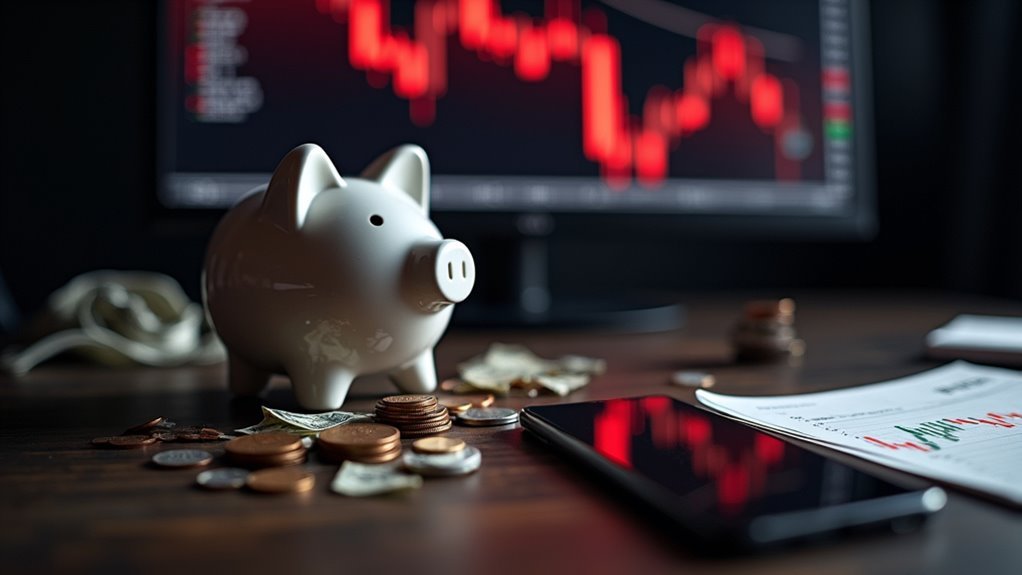Getting started with $100 isn’t just possible – it’s becoming the norm. Today’s investors can skip traditional barriers through zero-commission brokers, fractional shares, and micro-investing apps that turn spare change into stock holdings. High-yield savings accounts offer safe 3-4% returns, while index funds keep fees under 0.1%. Even peer-to-peer lending accepts $25 minimums. The investment world’s doors are wide open; stepping through them is easier than ever.

Many aspiring investors think they need thousands of dollars to start building wealth. The reality? A measly hundred bucks can kick-start a respectable investment portfolio. Thanks to modern technology and fierce competition among brokers, the barriers to entry have crumbled like a stale cookie.
Online brokers have revolutionized the investment landscape. Zero-commission trading, no minimum balances, and fractional shares mean investors can start with pocket change. Gone are the days of stuffy brokers in suits demanding hefty fees. Now anyone with a smartphone can trade stocks while eating cereal in their pajamas. Setting up automatic monthly contributions helps maintain consistent investment discipline. Dollar-cost averaging through these contributions helps reduce market timing risk.
Investing isn’t just for suits anymore – grab your phone and start trading while munching breakfast in your favorite PJs.
Index funds and ETFs stand out as popular starting points for small investors. These investment vehicles track broad market indices, spreading risk across hundreds or thousands of companies. With expense ratios often below 0.1%, they’re practically giving it away. Some investors start with just a slice of an S&P 500 ETF – like buying a single piece of a very expensive pizza. ETFs offer real-time pricing throughout the trading day, unlike mutual funds that price once daily.
Micro-investing apps have made investing almost embarrassingly easy. They round up daily purchases and invest the spare change – turning that $3.50 coffee into a mini investment opportunity. Sure, they charge monthly fees, but for many, the convenience justifies the cost.
High-yield savings accounts offer another avenue for small investors. With some accounts yielding 3-4% annually, it beats stuffing money under a mattress. FDIC insurance means the money’s safer than a superhero’s vault.
For those willing to embrace more risk, peer-to-peer lending platforms allow investments starting at $25 per loan. Returns can hit 5-7%, but defaults happen. It’s like being a tiny bank, just without the marble columns and free lollipops.
Smart investors also consider investing in themselves. Online courses, business tools, or relevant books can generate returns that make Wall Street jealous. After all, the best investment often isn’t in stocks or bonds – it’s in the person making the investment decisions.
Frequently Asked Questions
What Happens to My Investments if the Investment Platform Goes Bankrupt?
Most investors’ assets are protected when brokerages fail. The SIPC insures accounts up to $500,000, and regulations require firms to keep client assets separate from company funds.
Typically, accounts transfer smoothly to another brokerage. But crypto? That’s shakier ground. Shareholders and unsecured creditors often take the biggest hit.
The good news? Regular investors usually keep their stocks and bonds intact.
Should I Invest $100 All at Once or Spread It Over Time?
Research shows lump sum investing beats spreading it out 67% of the time over 6-month periods.
But there’s a catch – for nervous first-time investors, dollar-cost averaging can feel safer psychologically.
With $100, transaction fees could eat up returns if spread too thin.
Some people just dump it all in and forget about it. Others sleep better spacing it out.
The math favors lump sum, but emotions matter too.
How Do Taxes Work on Small Investment Earnings?
Small investment earnings still count to Uncle Sam.
Investment income gets taxed regardless of amount – dividends, interest, and capital gains all need reporting.
The rules are simple: short-term gains face regular income tax rates, while long-term gains get better treatment.
But realistically, tiny earnings might not even hit reporting thresholds.
Still, tracking everything matters for tax purposes.
Can I Withdraw My Money Immediately if I Need It?
Most investment accounts aren’t designed for quick withdrawals.
Taxable brokerage accounts? Sure, sell whenever. But retirement accounts like 401(k)s slap hefty penalties for early access.
ETFs and stocks can be sold during market hours, while mutual funds might take days.
Want instant access? That’s what savings accounts are for. Smart investors keep an emergency fund separate – because pulling out investments early is like throwing money out the window.
What Documentation Do I Need to Start Investing With $100?
Basic requirements include government-issued photo ID, Social Security number, current address proof, and bank account details for funding.
That’s the minimum. Most brokers also need employment info and income verification. Period. No fancy paperwork needed for small accounts.
Online brokers streamlined the process – fill out forms, verify identity, link bank account. Done.
Pretty straightforward these days.








